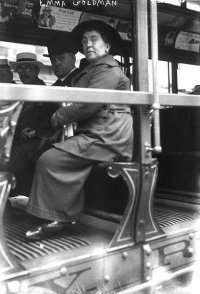Online Encyclopedia
Emma Goldman
Emma Goldman (June 27, 1869 - May 14, 1940) was a Lithuanian-born anarchist known for her radical libertarian and feminist writing and speeches. She emigrated to the United States at sixteen and was later deported to Russia, where she witnessed some events of the Russian Revolution. She also spent a number of years in Western Europe, where she wrote her autobiography and other works.
Goldman was born to a Jewish family in Kaunas, Lithuania, where her family ran a small inn. In the period of political repression after the assassination of Alexander II, she moved with her family to St Petersburg at the age of thirteen. There--due to economic hardship--she was forced to leave school and work in a factory. It was in that workplace that Goldman was introduced to revolutionary ideas; she obtained a copy of Cherychevsky 's What Is To Be Done , which sowed the seeds for her anarchist ideas and her independent attitude.
She fled to America with a half-sister after she refused to allow her father to marry her off at fifteen. The hanging of four anarchists after the Haymarket Riot drew the young Emma Goldman to the anarchist movement, and at twenty she decided to become a revolutionary. By this time she had been married for ten months to a Russian immigrant. The marriage didn't work out, so she left him and moved to New York. They remained legally married, allowing her to retain her American citizenship.
In New York City she met and lived with Alexander Berkman, along with whom she was a major leader of the anarchist movement in the United States at the time. Her defence of Berkman's attempted assassination of Henry Clay Frick made her highly unpopular with the authorities. Berkman (or Sasha as she fondly referred to him as) was jailed for several years.
She was imprisoned in 1893 at Blackwells Island penitentiary for publicly urging unemployed workers that they should "Ask for work. If they do not give you work, ask for bread. If they do not give you work or bread, take bread." (The statement is a summary of the principle of expropriation advocated by anarchist communists like Peter Kropotkin.) Voltairine de Cleyre gave the lecture In Defense of Emma Goldman as a response to this imprisonment. While serving the one year sentence, she developed a keen interest in nursing that later became her main source of employment.
She was arrested, with nine others, on September 10, 1901, on charges of conspiracy to assassinate President McKinley. A follower of hers, Leon Czolgosz had shot the President several days before. She met Czolgosz only once, briefly, several weeks before. She said about him, "Am I accountable because some crackbrained person put a wrong construction on my words?" Despite strong feelings against her among the public, she and the others were acquitted.
On February 11, 1916, she was arrested and imprisoned again for her distribution of birth control literature.
For several years, she expected to be arrested whenever she gave a speech, and therefore always carried a book when she got up on stage.
Her third imprisonment was in 1917, this time for conspiring to obstruct the draft: Berkman and Goldman were both involved in setting up No Conscription leagues and organising rallies against World War I.(illustration, left) She was imprisoned for two years, after which she was deported to Russia. At her deportation hearing, J. Edgar Hoover, directing the hearing, called her "one of the most dangerous women in America."
This deportation meant that Goldman, with Berkmann, was able to witness the Russian Revolution first hand. On her arrival in Russia, she was prepared to support the Bolsheviks despite the split between anarchists and statist communists at the First International. But seeing the political repression , bureaucracy and forced labour in Russia led Goldman to write My Disillusionment in Russia and My Further Disillusionment in Russia. Goldman was friends with fellow Communists and New Yorkers John Reed and Louise Bryant, both of whom were also in Russia at this time (during a period when it was impossible to leave the country); they may even have shared an apartment (see also the film Reds).
Her experiences in Russia helped change her ideas on the use of violence: after the Red Army was used against strikers, Goldman began rejecting violence except in self-defense.
In 1931 Goldman published her autobiography, "Living My Life," an amazing, insightful story now available on-line. (see link to Anarchist Archives)
In 1936, Goldman went to Spain to support the Spanish Revolution and the fight against Franco's fascism that was the Spanish Civil War. During this time she was to write the obituary of the prominent Spanish anarchist Buenaventura Durruti in a piece of vibrant prose entitled Durruti is Dead, Yet Living , which echoes Percy Bysshe Shelley's Adonais .
Emma Goldman died in Toronto and was buried in Waldhim Cemetery in Chicago, close to where the Haymarket Riot martyrs are interred.
See also: list of anarchists
External links
- Emma Goldman in the Anarchist Archives
- The Emma Goldman Papers (DL SunSITE)
- Anarchism and Other Essays
- BlackCrayon.com: People: Emma Goldman
- Emma Goldman Page at the Anarchist Encyclopedia
- http://dwardmac.pitzer.edu/Anarchist_Archives/goldman/living/livingtoc.html




